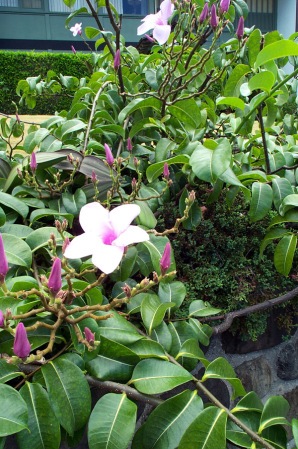
The rubber vine may appear to be a beautiful plant but it is actually poisonous. The vines will also creep up trees and into their canopies and foul up streams. (Photo by MISC)
When the crew from the Maui Invasive Species Committee (MISC) arrived on Moloka‘i in February of 2005, they soon realized this was not going to be just another week at work. They were assisting the Moloka‘i/Maui Invasive Species Committee (MoMISC) in controlling a large infestation of rubber vine plaguing the Kamalō and ‘Ualapu‘e areas. The pest had invaded over five acres, forming impenetrable thickets that made it difficult to control. Just looking at the vast amount of area conquered by this one invasive plant made the MISC crew realize why the two-person MoMISC team called in reinforcements.
Controlling the large population was a daunting task and, at first, overwhelming. But one by one, vine by vine, the crew attacked the rubber vine as if they themselves were an invasive species, quickly devouring everything in their path. By the end of the week, the once dark forest of rubber vine blanketing the treetops was transformed into a more open area with sunlight. By helping to initially suppress the pest, MISC was making it manageable for MoMISC to monitor and treat it in the future.
Here on Maui, we are fortunate that we do not have such large rubber vine populations. Instead, we have limited infestations growing in residential areas. There is hope that we can eradicate this invader before it affects our natural and agricultural areas as well as quality of life.
Rubber vine (Cryptostegia grandiflora on Maui, C. madagascariensis on Moloka‘i) are vigorous climbing vines from Madagascar that can scramble their way 30 meters up a tall tree or grow as an unorganized shrub-like clump of vines one to two meters tall. The plant invades waterways forming dense, impenetrable thickets that smother riparian vegetation and decrease biodiversity. Rubber vine can also impact ranching operations by restricting livestock access and lowering pasture productivity.
This invasive plant is extremely poisonous; it contains cardiac glycosides, chemicals that interfere with heart function in humans and animals when the plant is ingested. Contact with the plant’s milky sap can cause burning rashes and blisters. When the vine is dry, a powdery dust emerges that can cause violent coughing, swelling of the nose, and painful blistering of the eyelids.
Rubber vine has large, showy pinkish-purple flowers with five petals arranged like a funnel. Its shiny, dark green leaves, directly opposite each other, range from two to four inches long. The distinctive triangular seed pods average three to four inches in length and grow in wing-like pairs. Approximately 200 days after formation, the seed pods dry out and split open. Seeds with silky hairs are released into the wind and waterways. Approximately 95% are viable – increasing the potential for rubber vine to rapidly spread.
In addition to natural dispersal, rubber vine can be introduced to an area by animals or humans. Livestock can carry seeds long distances through agricultural fields. Contaminated vehicles and machinery transport seeds from one worksite to another. Cultivation of rubber vine as an ornamental plant makes the problem much worse, especially since a plant may live for up to 80 years. Rubber vine is widely available to the public through Internet seed companies, few of which describe the plant’s noxious qualities.
In order to prevent the spread of rubber vine, areas downstream and downwind from known infestations must be inspected. Do not import, purchase, or plant this toxic species in your yard. If you have rubber vine on your property, call MISC and give permission to control it. If you see rubber vine growing or for sale, call MISC at 573-MISC. Encourage friends and family not to buy this or other pest plants so nurseries will stop selling them.
We are happy to report that since MISC assisted MoMISC in February 2005, the five-acre rubber vine population has been significantly reduced and eradication of this pest is within reach for the Friendly Isle. Inclusion of rubber vine on the Hawai‘i State Noxious Weed List is currently under consideration. Until it is listed, it is up to residents and visitors to protect Maui from this aggressive pest so that we can avoid dealing with large populations such as that once found on Moloka‘i.
By Joylnn Paman
Originally published in the Maui News, January 13, 2008 as part of the Kia‘i Moku Column. Check out all of the MISC articles in the Kia`i Moku series at: www.hear.org/misc/mauinews/

Leave a Reply